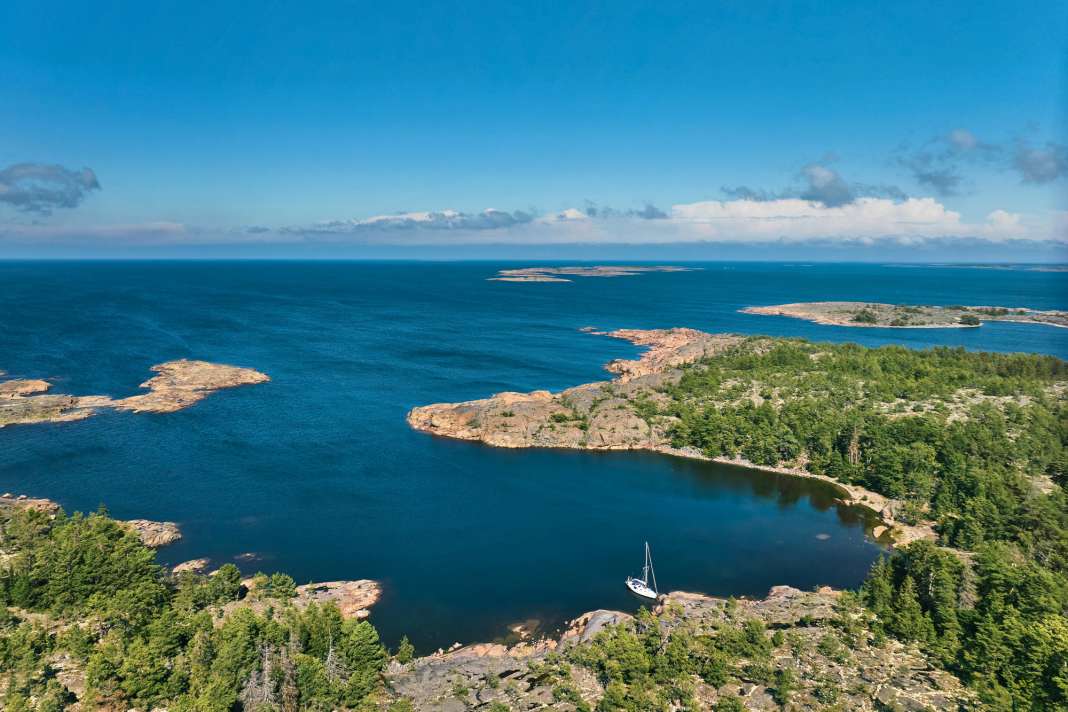





Visibility is almost zero. Fog has rolled in and the wind has picked up considerably, gusting to over 22 knots. "The first skerries should be appearing here soon," remarks Lisa, "then hopefully things will calm down a bit." Over the last few days, the Baltic Sea has piled up into high wave crests, and we are looking forward to entering the leeward zone of the Åland Islands soon. When we left the island of Gisslingö near the Swedish coast early in the morning, visibility was still good and the wind was moderate, but the weather in this part of the Baltic Sea can change even in summer.
Shadowy, flat rocky islands now appear on the port side. Heading north-east, we enter calmer waters and quickly approach our destination: Rödhamn. For centuries, the small rocky island with its high ridge and sheltered natural harbour has offered sailors protection and safe overnight accommodation, and is a popular place for skippers coming to Åland from Sweden. We look for a free spot on the jetty and tie up to the wooden jetty. We made it! Although it wasn't a long trip today, we are relieved to have solid ground under our sea boots again.
"Welcome to Rödhamn. I hope you had a good trip?" Anette Gustafsson greets us in the small café and harbour office and tells us everything we need to know about our stay. "And if you tell me how many bread rolls you want tomorrow morning, we'll bake them fresh and bring them to the boat!" This is the much-described hospitality on Åland, and the friendly nature of the locals will stay with us for the entire journey.
Creative cruise planning makes dreams come true
A trip to the Åland Islands has been on our itinerary for a very long time, and we know many pleasure boaters and sailors who have this archipelago of thousands of islands between Stockholm and Turku in Finland on their bucket list. It's not so much the sea areas on the journey that are a deterrent, as this can be easily managed by simply sailing along the Swedish east coast in predominantly sheltered areas. Rather, it is the sheer distance that often prevents a trip to these latitudes: It is around 600 nautical miles from Kiel to the Ålands, too much for the average summer holiday. However, creative cruise planning with night sailing, crew changes or booking a charter yacht from Stockholm, Turku or Mariehamn makes the dream destination a real experience.
The fact that we're actually here now, just stepping out of the hot wooden sauna, jumping into the slightly salty sea and then enjoying a sundowner against a perfect archipelago backdrop - that's pretty unreal. "Pinch me," says Lisa, "is this all real, or are we extras in a tearjerker film by Inga Lindström?" Yes, it's all exactly the same. Even the fresh, fragrant bread rolls in our cockpit the next morning. Anette Gustafsson has written the weather forecast on the sandwich bag with a thick felt-tip pen: "Wind from the south-west and sunshine."
"Next stop: Mariehamn!" announces Lisa after a cosy breakfast on board. The wide fairway is a breeze to navigate, but it's the huge ferries and cruise ships that are more frightening, as they can come up quickly and create a considerable wake. Especially when manoeuvring in front of the Mariehamn harbour terminal, the propeller water of the steel giants can throw the small boat driver off course. "Up to 30 large passenger ships moor here every day, some only stay for a few hours. There's always a lot going on here," Johan Grönroos from the harbour authority tells us on enquiry, "leisure captains therefore have to be very vigilant."
Days and nights of marvellous silence and magnificent nature
Directly behind the ferry terminal, we pull into the guest harbour of Åländska Segelsällskapet (ÅSS) and are guided to the right spot by the harbour master in a rubber dinghy. Here we are sheltered and have a direct view of a maritime heritage and the city's landmark: the four-masted barque "Pommern", one of the legendary Flying P-Liners.
Before going ashore, Lisa speaks up: "The to-do for us tourists is: maritime museum, city tour and sauna on the jetty. Then dinner at the ÅSS Paviljongen restaurant with smoked mussels, chanterelle ravioli and baked cod with flambéed lemon." No objections on my part, we conscientiously and cheerfully complete every item on the list. We have a sundowner above the marina, a vantage point on the rocks with a sweeping view over the harbour and the archipelago.
Do Ålanders realise how lucky they are to live here?
After urban diversity and gastronomic delights, the crew is ready for a few miles in the fresh sea air. We head north to some of the many thousands of skerries, whose reddish rocks and green pines glow beautifully in the blue water and have names like Jungfruskär, Hundklobben or Boxö. Some of the popular bays and natural harbours are already occupied by other yachts from midday, so we learn to read between the lines of the cruising guide and not head straight for the recommended places. These are days and nights of marvellous silence and magnificent nature. "Do the Ålanders actually realise how lucky they are to live here?" Lisa asks me. A rhetorical question that we should perhaps ask again in winter. We certainly appreciate our good fortune, here and now in the warm light of the summer sun.
Archipelago with a firework of chlorophyll
A few days later, in choppy waves, we cross Lumparn, an inland area surrounded by the main islands, and a few miles and cries of seagulls later we enter the narrow and sometimes shallow fairway of Slottssundet.
After the barren archipelago and the countless piles of stones draped in a wide ring around the main islands, visitors to the interior of the archipelago are greeted with a firework display of chlorophyll: deciduous trees, firs, pines and lush meadows are covered in all shades of green. An oasis in the middle of the Baltic Sea. The shores are lined with reeds and grasses, it is the old cultivated land of these islands, the granary of the earliest inhabitants.
And also the former centre of power, which emerges impressively behind the last bend in the sound: Kastelholms Slott. The castle dates back to the 14th century and was for a long time a stronghold of the Swedish crown. After looting and fires, the castle has been reconstructed over the last 30 years and the former ruins are now the most visited sight in Åland. An impressive site, an open-air museum has been created around the castle with historic farm and fishermen's houses. "There's a big midsummer festival here, where we celebrate the highest position of the sun for a few days," says Melina from the guest harbour, just a stone's throw from the castle.
Melina's family has been in charge of the marina for two years, renovated the harbour with 100 berths and the service facilities, built a sauna and conjured up a fine little menu for the bistro with home-made local specialities. The atmosphere here is friendly and informal, and Melina also has good tips for her guests: "You have to go to Bomarsund to the old Russian castle and then definitely to Vargata with its small harbour and museum!" Melina can hardly contain her enthusiasm.
These are of course lots of great ideas for our travel plans, but we couldn't manage them in the two weeks we had planned. "Then just come back next year!" laughs Melina. She's right, this beautiful and varied nature, the many opportunities to anchor in natural harbours, lie directly on the rocks or land in the small harbours and explore the places. And last but not least, the friendly and helpful Ålanders are well worth the trip. Even if it is many, many miles to get there.
Autonomous island world Åland Islands



The dream destination of many water sports enthusiasts lies in the northern Baltic Sea, roughly the same width as Stockholm and Helsinki, and consists of more than 20,000 islands and skerries, 6,700 of which are labelled by name and the larger ones are mostly connected by bridges and dams. The main island of Fasta Åland is the largest island, covering over 1,000 square kilometres, and almost all of its 30,000 inhabitants live here.
Throughout history, the islands have been the plaything of powers: The Swedes ruled in the Middle Ages, later fought with the Danes and were finally defeated and driven out by the Russians in the Great Northern War. Then it was Sweden's turn again, followed by Finland. Today, Åland is part of the territory of the Republic of Finland, but since 1921 it has enjoyed the special status of an autonomous region guaranteed under international law; this is intended to preserve a traditionally Swedish-influenced culture. According to the constitution, Åland is monolingual Swedish and has been a member of the EU since 1995, but outside the fiscal union. The currency is the euro. As transport and shipping are favoured with special tax regulations, the headquarters of large shipping companies are located here.
Cruising tips: Åland
Rödhamn - Skerry with bakery
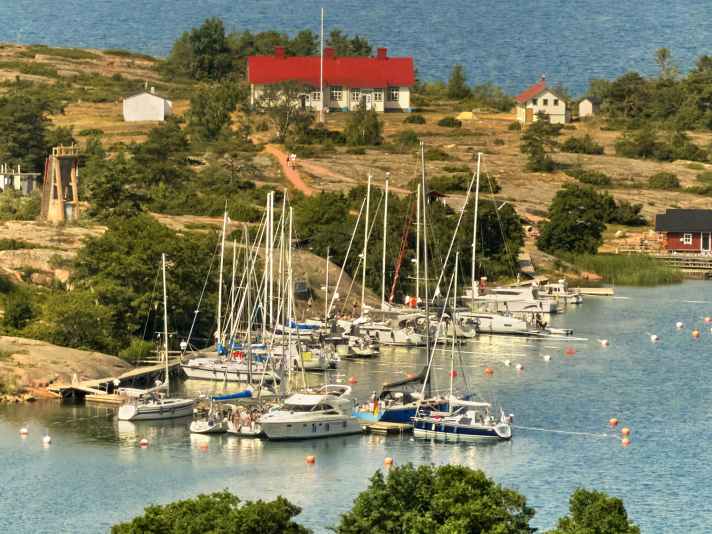
The natural marina south-west of Mariehamn is a favourite spot for sailors and pleasure boaters, sheltered from westerly and southerly winds. Don't miss: a sundowner at the old pilot station on the hill and enjoy the sweeping views. Order bread rolls for tomorrow, eat smoked fish. Maritime: moor at the stern buoys and jetty or floating dock. Sauna to order.
Mariehamn - the maritime centre of Åland
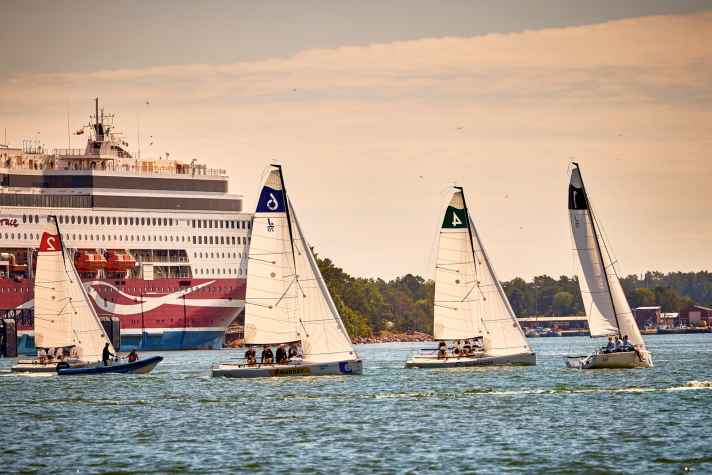
The harbour town has always been an important hub, with ferry and boat traffic still busy today. Founded in 1861 by Tsar Alexander II, named after his wife Maria and built according to the Russian model: wide straight streets and avenues lined with deciduous trees to limit fires and protect the wooden houses. Situated on a peninsula, the former tsar's city is easy to explore on foot: from east to west it is just a ten-minute walk.
Don't miss: Shipping museum with the P-Liner "Pommern". The former German cargo ship was bought in 1923 by the shipowner Gustaf Erikson from Mariehamn, who owned the largest sailing fleet in the world at the time. Stroll along Lindenallée to the Torggatan shopping street and dine in the historic ASS Paviljonen right by the western marina. Maritime: First choice is the ÅSS Marina on the west side of the city with very good service facilities and sauna. Moorings at the stern buoy in front of the jetty or mooring buoys. Yachts are also well moored at Mariehamns Seglarförening in the east of the city with the largest marina in the region.
3 Länsmansgrund - natural harbour
On the southern Bothnian Sea lies a typical outer archipelago, overgrown with heather and sea buckthorn with a bay on the eastern side. A must-do: Picnic at the small hut with a fireplace and firewood. Maritime: Narrow, deep entrance, rings in the rocks to the west.
4 Kastelholm - living history
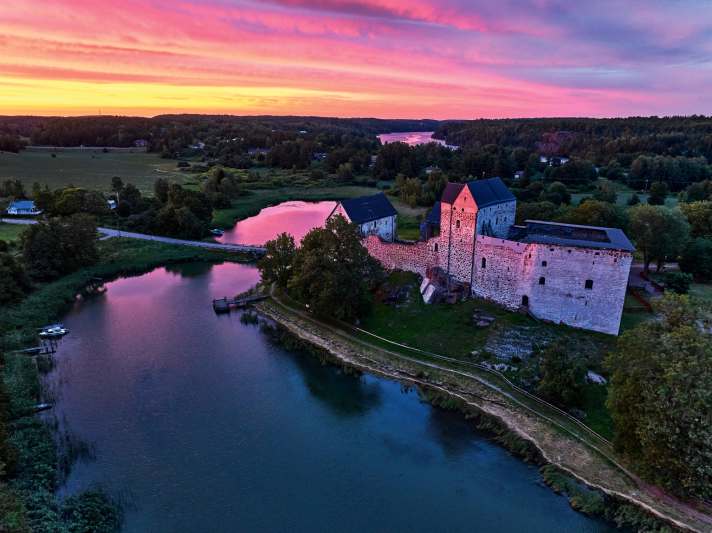
Kastelholm Castle is the most important historical sight on the islands. A must: Visit the fortress and the Jan Karlsgarden open-air museum with old farmhouses and traditional festivals. Next door is the Åland Gin Distillery, where you can get the flavour of the island in bottles. Then onto the green: Golfers from all over the world appreciate the greens of the nearby Åland Golf Club. Small dishes in the bistro at Melinas Marina right by the marina with recipes from the region. The new harbour operators have created a family atmosphere and help with any questions. Maritime: 100 guest berths, good service facilities with sauna. Petrol station in the harbour.
5 Bomarsund - Fortress

The once mighty fortress of Bomarsund was the outpost of Tsarist Russia and was destroyed in the Crimean War of 1854. A must-see: Visit the ruins and the visitor centre. Maritime: There are around 50 moorings in the bay, which is open to the north, and a jetty on the rock makes mooring easier. Electricity at the jetty, sanitary facilities at the campsite (approx. 300 metres).
Area information: Åland
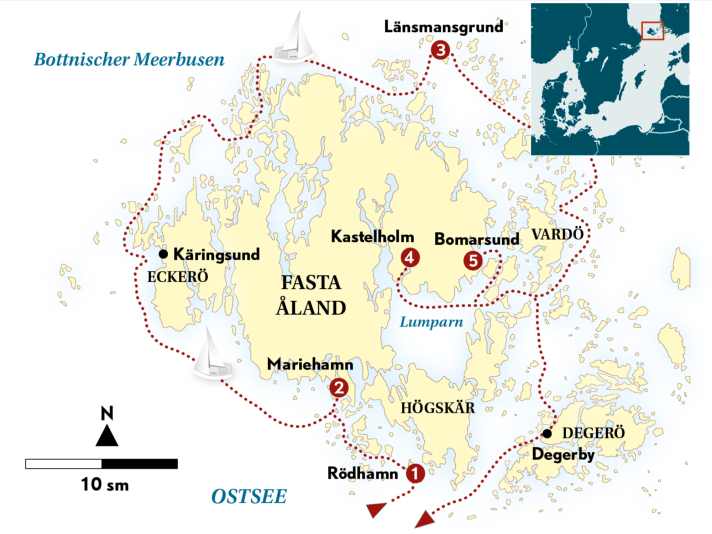
Climate
The island location in the middle of the Baltic Sea allows for a moderate climate; it doesn't get really hot here. In summer it is around 15 to 19 °C, as the sea cools the hot south-easterly winds. Nevertheless, with around 1,900 hours of sunshine a year, the islands are one of the sunniest regions in Finland. It remains pleasant even in late autumn, as the Baltic Sea retains the warmth of summer and only cools down slowly. In summer, the wind usually blows moderately around 3 Beaufort from predominantly southerly directions.
Attention, season!
During the summer holidays in Finland and Sweden from mid-June to August, the harbours, moorings and bays become very crowded. If you can manage it, you should avoid popular places or choose an alternative period for your cruise. In September it is usually still warm and the water temperature is pleasant.
Marinas and natural harbours
Away from the large harbours, the marinas are often small and fill up quickly during the season. Harbour masters and guest berths endeavour to accommodate late guests. The stern is usually moored to a buoy or anchor and the bow to a jetty. The service facilities and harbour facilities vary, and the supply of water, provisions and diesel is almost always available. Prices for a 40-foot yacht are between 30 and 40 euros including electricity during the season. Booking and payment also via the Dockspot app (www.dockspot.com/de/) or from the harbour master.
For experienced Scandinavian boaters, mooring to the rocks is the best way to get close to the landscape. Prerequisite: stern anchor and rock hook and many metres of shore lines. Do not moor close to the ferry channel, as the displacement of the large ships causes considerable changes in the water level. Anchoring in shallow bays and between the skerries is possible, then the dinghy or a SUP is the right companion for shore leave.
Safely through the archipelago
The fairways are usually well buoyed or sprayed and, depending on the wind direction and cover, allow safe passage even in heavy weather. An individual course through the islands is also possible, and a cruise along the rocks and islands is feasible if the position and course are consistently checked against paper and pixel charts. Caution is advised in the shipping lanes of large ferries and cruise ships. Åland is a transport hub for traffic between Sweden and Finland, and there are also cruise ships from all over the world. The high speed of these giants, the heavy swell and enormous displacement must be taken into account. Radio: Mariehamn Channel 27, Sea Rescue Tel. 02 04 10 00
Natural nature
The right of public access (Allemansrätt), which is widespread in Scandinavia, also applies to Åland; you can moor and enter almost anywhere. Exceptions: Recognisable or marked private land and designated nature reserves are taboo, fires are only allowed in designated places and rubbish must be taken away. Body-covering clothing and appropriate sprays help against ticks. Vaccination against tick-borne encephalitis is advisable. Mosquitoes can also be present in large numbers; sprays, smoke spirals and fly nets provide protection.
Literature and nautical charts
- Finnish boat prospection charts C "Aland"; Åland Islands - The 50 Best Harbours, Brixham Books
- Suuri Satamakirja II - Cruising guide Aland Islands. Reference: www.hansenautic.de
There+Away
It is about 70 nautical miles from Stockholm to Mariehamn on your own keel, 80 from Turku in Finland to Mariehamn and 150 from Helsinki. Charter companies offer yachts on Åland or on the Swedish and Finnish coasts: www.boote-yachten.de, www.bohuscharter.com

